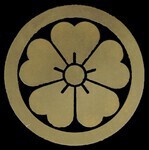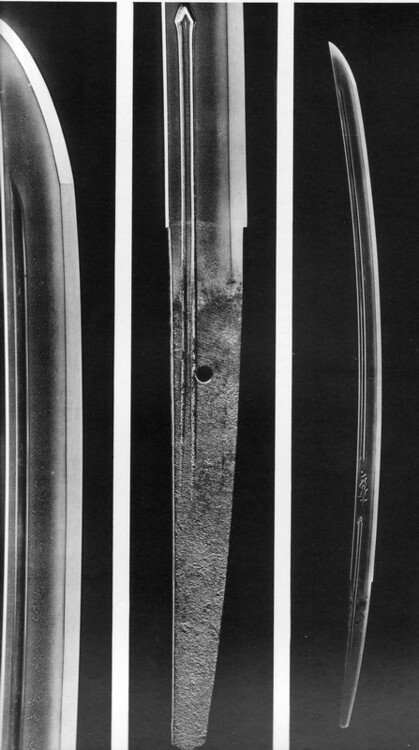-
Posts
3,242 -
Joined
-
Days Won
99
Content Type
Profiles
Forums
Events
Store
Downloads
Gallery
Everything posted by Guido
-
It's not "shu" but "jû (sumu) 住" - however, I agree that that it doesn't match.
-
I got this info from 梶原皇刀軒's 日本刀用語辞典. I already found some other mistakes in that book in the past, so I wouldn't rule out that this is yet another mistake / wrong Kanji. If you get more info on it please let me know.
-
As mentioned above, Japanese authorities simply don't have the manpower to cross-check every sword coming into Japan. I actually never heard about any case, and proving that it's the same sword (if it isn't published) should be very hard. I've attended licensing Shinsa, and they just issued licenses, no questions asked. However, if you're caught in the act of shipping a sword out of Japan with its license still attached (or the other way around), you're doomed.
-

Request with Hira-zukuri Ko-wakazashi please
Guido replied to D-Lewis's topic in Translation Assistance
Let me quote from my Koshirae article: -
2 = how this part of the blade is called, 4 = a measurement (i.e. a straight line). That's btw why I post the pics here before submitting them as an article, so people can point out mistakes and make suggestions. Any ideas how I could make it more clear what is meant?
-

Request with Hira-zukuri Ko-wakazashi please
Guido replied to D-Lewis's topic in Translation Assistance
The answer is pretty simple: Kodachi! Koshigatana is an old term for Tantô, and Chiisagatana are Tantô mounted with Tsuba, Tsukamaki etc. -
Chances that the Bunkachô is monitoring this website are remote, I don't think any harm would come of it. Anyhow, I know a dealer (most of you do, too) who lost his sword dealer's license over this. He's now running his shop with the license his wife obtained, continuing the practice of shipping swords abroad without de-licensing them - but much more carefully ...
-
Just to prove that I didn't forget my promise - however, work comes first, and my skills with graphic software are less than stellar ... TOSHIN.pdf
-

oil used before petrolium products
Guido replied to Stephen's topic in General Nihonto Related Discussion
Yes, I acted as temporary curator at that exhibition. A phantastic show, but a royal pain in the neck to organize. If nothing else, It taught me a lot of respect for people who do this for a living. A gazillion little details and last minute improvising to make it work - I fell in a coma after opening day! As to Mr. Yoshihara: he's a fine smith for sure, but the hype surrounding him is getting quite annoying. If we believe all the stories that circulate outside Japan, he basically reinvented single-handedly all secrets of the smiths of old, and is at the same time the most innovative smith that ever lived. Well, he's surely without peers when it comes to finding people to promote his work, besides his own brilliant work in this endeavor; a true master of "sword politics". Just my 2 Renminbi. -

oil used before petrolium products
Guido replied to Stephen's topic in General Nihonto Related Discussion
The use of mineral oil in quenching is another invention that came with the mass-production of swords for the wars of modern age. It's assumed that in early times Yakiire was done without any clay application at all. Smiths like Kojima Naohiro are quite successful in reproducing Yamatorige-like Chôji for some time now. -

oil used before petrolium products
Guido replied to Stephen's topic in General Nihonto Related Discussion
Traditionally vegetable oil was used, usually camellia oil (Tsubaki-Abura 椿油) with a few drops of clover oil (Chōji-Abura 丁子油). It has a yellowish color, and strongly smells of cloves. It absorbs moisture, but gums up easily when dried. It's also mildly aggressive (which is good for cleaning swords in a less-than-perfect state of preservation), but quite messy when it soaks into the Saya. Mineral oil (Kōbutsuyu 鉱物油) was used from the Meiji era on when mass-production of swords for the Japanese army started - it's cheaper and easily obtainable. It's clear, and thinner than vegetable oil, and doesn't deteriorate as fast; one also needs less of it compared to Chōji-Abura (as Chōji scented oil is called for short). -
-
Well, I'm not a lawyer so I don't know - but suspect - that it's copyrighted. In any case, I believe in sharing information freely, so if someone asks, he shall receive. In other words: feel free to post it on your site.
-
No cut and paste, dude, I typed that stuff myself! In the Chôshûya pic were a couple of minor mistakes which I corrected, and I added quite a few terms. That's why it takes me so long ...
-
Yeah, right! :lol: O.K., attached is the first installment. Looks a little smallish at first glance, but you can zoom in with Adobe Reader; it also prints out o.k. I have lots of high resolution pics of swords, and will try to take some more pics of my Koshirae. What I don't have in abundance is time, but I'll try to finish everything during the next week. No promise, though. TACHI.pdf
-
Something like this? It's my own Koshirae, so no copyright issues. However it might take me a couple of days to provide the finished products.
-
Matt, try to think the other way around: a Russian approaching me, trying to give me the Mauser his grandfather took from my grandfather after he stepped on the Russian's land mine that ripped him into pieces. As honorable as the intentions on both sides are, some things in the past should be laid to rest, not old wounds opened again. Just my very personal opinion.
-
It has a star stamp, so chances are it's traditionally made, not mass-produced. However, not having a surrender tag (since it wasn't exactly "surrendered") makes finding the descendants of the owner virtually impossible. And even if you could locate them, I'd think twice about asking them "do you want the sword of your grandfather back that my grandfather took from him after he / his buddies killed him?" Possibly not a great conversation starter ...
-
Cheers - I hope it goes well with Uni! :lol:
-
-
I suspect that we're looking at a Chinese fake when you post additional pics of the entire sword ...
-

Manchuria blade translation.
Guido replied to Henry Stewart's topic in General Nihonto Related Discussion
Still beats me why I gave the correct explanation in the intro of the article, and then messed up the chart. Anyhow, a corrected version with some additional info and easier to use chart is on its way to Brian for uploading. I also deleted the list of years, and will include it in a Nengô chart soon to be added to the article section. Thanks again to Koichi-san for pointing out my mistakes; I hope no one lost any sleep - or, worse, money! - over my flawed article! :lol: -

Manchuria blade translation.
Guido replied to Henry Stewart's topic in General Nihonto Related Discussion
That should teach me to edit the article in a hurry! I'll get to it right after work, and will ammend it with I story I left out as a bonus. :D -

Manchuria blade translation.
Guido replied to Henry Stewart's topic in General Nihonto Related Discussion
Just when I thought "damn, am I good or what, *I* got it right", Koichi told me in a PM that I reversed in the table of "ETO 干支" the positions of 兄 and 弟 - "e" is 兄, and "to" is 弟. Bummer! I'll send the corrected article to Brian asap! -
I saw the thumbnails just fine a couple of minutes ago, but now there are only little red crosses ... Barry, working from memory (since the pics are gone) I don't think your blade is a 1:1 copy (Utsushimono) of the Kiriha Sadamune (see attached scan).





